Ongoing Care
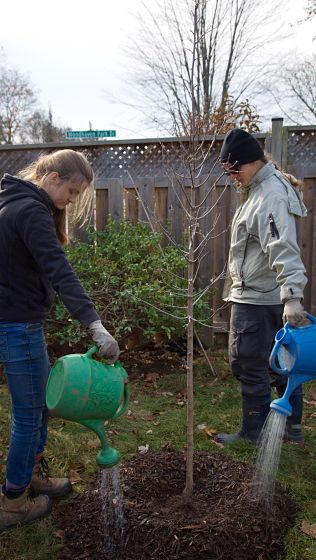
On average, young trees should be watered twice per week, using approximately 6 gallons of water each time. This is the equivalent of using 3 full watering cans twice per week, or using a hose with no nozzle on a very slow trickle for approximately 15 minutes, twice per week. When in doubt, check the soil under the mulch - if it feels damp and cool your tree should be good for another day, but if it feels hard and dry, your tree is in need of a drink!
For older trees (3 or more years after planting), water as needed from spring through fall. Check the soil in the root area weekly (as described above). This is particularly important during the dry summer months!
Never use a sprinkler to water your tree. Wet leaves can be prone to fungal disease.
Never over-water your tree. If the soil is already wet or there is standing water under or near your tree reduce your watering duration and/or frequency. This is particularly relevant for heavy clay or compacted soils.
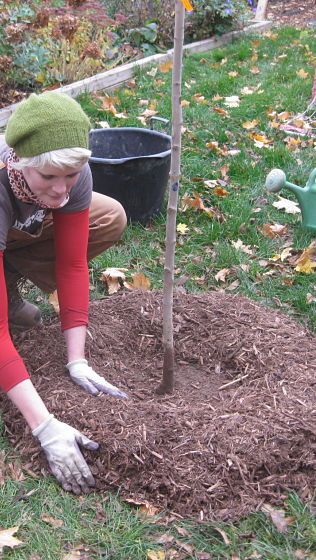
Mulch your tree twice per year. Spread mulch (undyed woodchips and/or leaves/compost) in a circle around your tree, as far out as you are willing. The bigger the circle, the better for the tree. Ensure that the mulch is not more than two to four inches deep, so that roots can still get oxygen. Keep mulch in a “doughnut” shape, leaving about six inches of space around the trunk.
Tip: Never pile mulch in a “volcano” shape around the trunk as this holds moisture and causes decay.

Use organic compost to improve soil health. Adding a one-inch layer of compost around your tree, under the mulch, or top dressing by sprinkling over mulch will improve soil quality and overall tree health. Remember that leaves are nature’s compost – leaving your leaves, rather than raking them in the fall, is one of the best things you can do for your tree!
Avoid using high-nitrogen, synthetic fertilizers on your lawn and garden. Nitrogen can cause a rapid increase in the top growth of your tree before the trunk is large enough to support it. This can result in a “bent-over” tree. Adding organic compost is a more balanced and natural way of feeding your lawn and garden, and will also be beneficial for your tree.
Avoid the use of pesticides and herbicides. Trees often suffer “chemical burn” when pesticides or herbicides are applied to lawns. This can be fatal. Chemical pesticides can also be harmful to beneficial insects, butterflies and songbirds, not to mention humans and pets. Always use non-toxic alternatives to chemical pesticides. For serious infestations, contact an ISA-certified arborist. Inquire about non-chemical methods of treatment
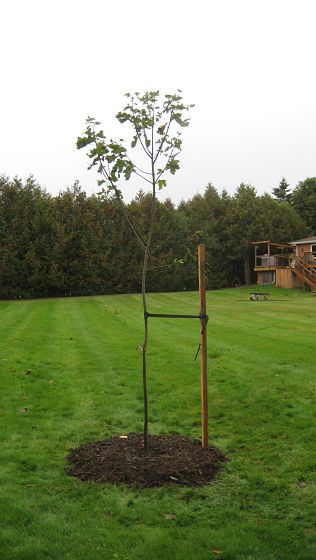
Newly planted trees sometimes require temporary staking. This is usually only the case if the tree is at risk of vandalism, is large or top-heavy or is located in a windy area. Young trees will move in the wind, but are unlikely to blow over. Some movement in the wind is good, as it causes the tree to respond with greater root and trunk growth, anchoring the tree more securely.
Staking is not the way to deal with leaning trees. Trying to pull or force a tree to grow in a certain direction can cause severe structural damage and can actually worsen the lean. It is better to remedy the situation causing the lean.
Young trees may lean if they are sun-loving, but have been planted in partial shade -- essentially, they are reaching for light. It is best to avoid this problem by understanding the sunlight needs of any new trees you plant. Correcting the problem after planting is usually only possible by removing the source of the shade. This may mean pruning overhanging branches of other trees – contact an ISA-certified arborist for your pruning needs. Once the light reaches the younger tree evenly, it should compensate with growth and straighten itself.
Sometimes, trees will lean if too much growth has occurred on top, before the trunk can support the weight. This often happens after lawn or garden fertilizing (which is high in nitrogen) causes a rapid rush of leaf growth. Depending on the individual tree, weight may be able to be removed by using proper pruning techniques. Contact an ISA-certified arborist for pruning. The tree will usually resume a more upright position once the extra weight is removed.
If you decide to stake your tree on your own, use only soft, flexible materials that will not cut into the bark, and put stake(s) in at least two feet away from the trunk. Always remove the stake(s) after one year. As the tree grows, ties can cut into delicate conductive tissue located just under the bark of the tree, causing serious damage.
Specialized Care

Only prune broken, dead, diseased or damaged branches during the first two years after planting.
As trees grow, they do not necessarily need to be pruned. However, if there are complicating issues with branch structure, it is best to correct them when the tree is young. Structural pruning is usually done three to five years after planting, depending on species and rate of growth. This may include removing branches that cross, grow too closely together or grow in undesirable directions. Structural pruning may also be used to correct double or triple leaders - most tree species should only have one main leader (the vertical stem at the top of the trunk).
Never remove more than a quarter of the leaf area of a tree in any one year as this causes too much stress to the tree. Leaves are sugar-producing factories so if the tree loses too many at once, their ability to produce their own food can be greatly inhibited.
Never use wound paint after pruning as this interferes with the natural wound compartmentalization abilities of the tree. If you think your tree needs pruning, follow these tips to select a qualified tree care company. More information on pruning can be found here.
LEAF does offer corrective pruning services for young trees that LEAF has planted. Trees must be less than 14 feet (4 m) in height as we do not perform any “off the ground” work.

Trees are often vulnerable to physical damage, especially in urban settings. Often we are unaware that damage is being done.
Never tie or attach things to trees. Rope, string or wire tied around any part of a tree can girdle the bark, impede the flow of water and nutrients within the tree, and cause serious damage. Also avoid nailing bird houses or other objects to trees, as these create entry wounds for pests and disease.
Never mow or weed-whack close to the trunks of trees. This causes serious injury to the protective layer of your tree (bark) and destroys the delicate tissues just under the bark that transport water and nutrients up to the branches. A ring of mulch can help avoid this!
Never install hard surfaces such as paving, interlocking bricks or patio stones near the trunks or under the canopies of trees. These materials are impermeable and will prevent both air and water from penetrating the soil (both of which are essential to roots and tree survival.)
Never pile or store things like construction materials, soil or even mulch under the canopy of your tree. Anything that oxygen and water cannot easily penetrate will be an impediment to tree roots and potentially fatal.
Never compact the soil under the canopies of trees. Activities such as construction, paving, grading, and driving can compact the soil, reducing the space available for the air and water needed to survive. Soil compaction also reduces the function of beneficial soil microorganisms that help provide organic matter and nutrients.
If you are doing renovation or construction in your yard, make sure to establish wide protection zones around your trees. There are many ways that tree roots can become damaged from construction, which can result in weak foliage and leaf loss. Declining tree health may not become apparent until years after the damage occurs. When establishing tree protection zones, keep in mind that roots can extend out up to three times the height of the tree.
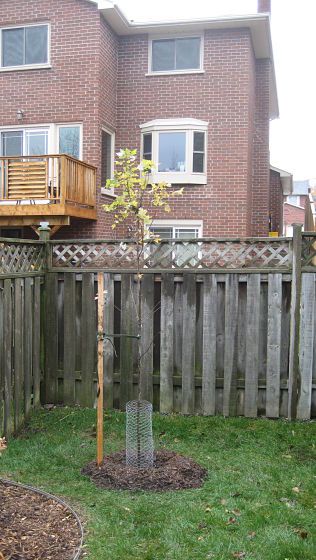
Replenish the mulch around your tree before winter to ensure roots are insulated from freeze/thaw cycles.
A plastic tree guard or wire mesh around your tree will protect the base from chewing rodents/rabbits. Tree guards should be retractable and breathable, to allow your tree to naturally grow with the guard on. Be sure to remove all tree guards in early spring when temperatures start to increase in order to avoid moisture build-up along the trunk (which could lead to decay).
Avoid using salt near trees in winter. Salt applied to walkways, driveways, and porches eventually works its way into the ground, negatively affecting trees. Try chopping away ice in winter and using sand or other earth-friendly alternatives.
Native evergreen trees are hardy and can generally withstand our harsh winters. However, if your tree is exposed to salt spray (sometimes a risk near highways) place four stakes around your evergreen tree and wrap burlap around the stakes. Be sure to leave space between the burlap and the foliage/branches to allow air circulation.
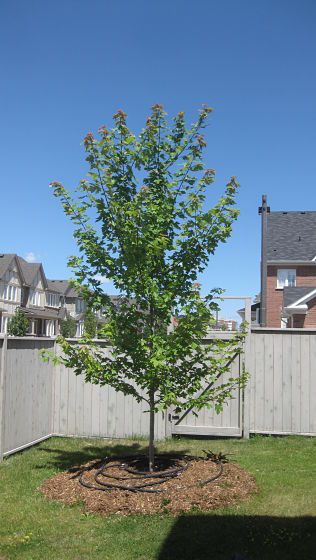
Top 10 Things You Can Do For Your Trees
Newly-Constructed Homes: Making Your Soil Healthier for Trees
For detailed information on these and many more tree care topics, check out the ISA Tree Owner Information factsheets.
